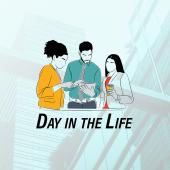Artwork by rumka_vodki/Shutterstock.com.
There is much anticipation as we cautiously make our way back to in-person events, such as the ACC Annual Meeting. I have yet to attend an in-person ACC meeting; my first two ACC Annual Meetings were virtual. If I am lucky enough to attend this year, I would technically be a first-time attendee. For many people, this prospect is exciting; I, on the other hand, am full of trepidation and anxiety. Why? Well, it is partially because I’m getting used to being around people again; the re-acclimation struggle is real. But mostly, it is because I am an introvert and cripplingly shy.
I have worked tirelessly on what some might call “opportunity areas” and have painstakingly trained myself to become a “situational extrovert.” Various social settings are often equal parts uncomfortable and draining (physically, mentally, and emotionally) for me. I feel awkward and self-conscious as my shyness takes hold. Personally, I don’t like the characterization that introverts and shy people need to be “fixed” or that there is something inherently wrong with people like me, which is how I’ve felt when it has been suggested I work on this as an “opportunity area,” or that I “try to be more outgoing.” That’s not who I am, and that ought to be OK.

Being an introvert and being shy are often conflated. Introversion is a personality type, while shyness is an emotion. Shyness indicates an apprehension or anxiety related to certain (usually large groups of) people or social situations. Introverts do not like spending lots of time interacting with other people; it drains their energy. Not all introverts are shy and not all shy people are introverts (extroverts can be shy, too). Find out if you’re an introvert.
How to engage as an introvert
To get the full value of an in-person conference experience, I’ve used a variety of different approaches and strategies with varying degrees of success.
Seek connections
I have scoured attendee lists for names I recognize in hopes that I can connect with familiar faces. I have connected in advance, through LinkedIn and virtual conference platforms, with other registrants to schedule meetings, dinners, and other events, and build my network.
I have connected in advance, through LinkedIn and virtual conference platforms, with other registrants to schedule meetings, dinners, and other events, and build my network.
Be vulnerable
I’ve worn the (sometimes dreaded) “FIRST TIMER” ribbon.
Volunteer
Introduce speakers, moderate panels, and be a “microphone runner” in the audience. This gave me a purpose other than feeling out of place, and it was a way to see and be seen among my peers.

Be a speaker, panelist, or moderator. These opportunities allow us share our experiences in a way that doesn’t feel too uncomfortable, and to connect with other (often like-minded) attendees after the presentation.
Serve on planning committees for events, which can encourage you to speak up and generate connections that span beyond the specific event. I was privileged to serve on the planning committee for the 2022 ACC Annual Meeting. It was an amazing experience. One of the other volunteers even commented, “Wendy, where have you been hiding? I’m so glad we found you.” As I told that kindred spirit, I was likely there, blending into my surroundings, trying to hide my awkwardness and extreme discomfort. THANK YOU for seeing me!
Staff registration booths and information desks can also use volunteers.
Participate
Engage in the chat function during virtual meetings — asking questions, making (hopefully relevant) comments. I sent private messages to individuals who said something insightful or that really resonated with me.
How others can assist first-time attendees
But I got to thinking that maybe this is could (should?) be a two-way street. What are some ways returning (not necessarily first-time) attendees, or those who are extroverts, ambiverts, and/or less shy can help everyone more fully participate in and enjoy their conference experience?
Seek connections
In-person conferences often have a “first timer” type of ribbon for our name badges. For those of us brave enough to wear them, it is a message to others that we might be a little overwhelmed.
Reach out to start a conversation; first timers won’t know the etiquette about this, and the unwritten rules at each conference are different. I attended a conference once where, “overwhelmed,” was one of the ribbon options. If such a ribbon is an option at your next event, watch for it. That might be a clue that someone is feeling … overburdened.
Don’t be a stranger
First timers, introverts, some ambiverts, and people who are shy tend to arrive early to sessions not just to avoid mingling in the expo hall or corridors, but also to scope out the area and find our preferred spot to sit, or maybe blend into our surroundings. Come early and help us find our way.
Include everyone
Because we get to sessions early (or because we are shy, introverts, or both), we are likely sitting alone at a table. Engage us.
How many times have you attended this conference? Where are you from? Why did you choose to attend this session? How are you enjoying the conference so far? What’s been your favorite session of the conference? What did you think of the keynote speaker?
This sounds simple when I put it in writing, but when in the situation, it is anything but. What is simple may not be easy.
Come prepared
Believe it or not, all associations and meetings have cliques. We think we are inviting or welcoming to new people, but long-time colleagues send a strong vibe that their group is not accepting new members, so newbies won’t try to join an in-process conversation. Introverts often feel it is rude to join an in-process conversation and won’t look for or identify an opening to join the discussion. If you see us lingering, invite us to engage.
Introverts often feel it is rude to join an in-process conversation and won’t look for or identify an opening to join the discussion. If you see us lingering, invite us to engage.
This is also true in virtual meetings. I attended a virtual “happy hour” hosted by a law firm designed specifically for in-house counsel. The host law firm spent so much time chatting it up with their existing clients, those who were not existing clients couldn’t get a word in, were never asked to join the conversation, and left feeling frustrated. And, I can tell you that law firm lost out on more than one new client.
Plan future gatherings
Review the registration list for others in your state or industry. Reach out in advance of the meeting via email, LinkedIn, the conference platform or other medium. Several of the virtual conference platforms have connection and messaging capabilities. This feature was available in the “before times” for in-person conferences, but it was rarely used. It will be interesting to see how, in the “new normal” such platforms are used as we return to in-person or (more likely) hybrid conferences.
Make everyone comfortable
Have a reception or designated meeting space for first timers to take off some of the pressure. Coordinate next-day meetups at the continental breakfast or expo break to continue conversations or give people a place to go when they’re feeling overloaded. If you do make a connection, there are multiple opportunities to reconnect for informal get togethers, an awards dinner, or other special events throughout the conference. Invite others to join you at your table.
Spread the love
Invite someone you don’t know into your group at every session, keynote, meal, or impromptu expo hall conversation.
Have a pre - or early conference session devoted to “speed networking,” and/or provide opportunities for affinity networking groups to connect. Provide (optional) questions or incorporate an icebreaker activity to get people talking. Limit the discussions to 5-8 minutes, then move to the next person/table. This helps build connections while not having to find an entry point to an existing conversation.
When held early enough in the conference, “speed networking” provides individuals with a friendly face during later parts of the conference. Some of my favorite icebreaker questions are:
- If you could have one superpower, what would it be and why?
- If you were a professional athlete, what would your walk-up song be?
- What is your favorite treat/ice cream flavor, pizza topping, etc.?
- Who is your favorite entertainer, and why is it Donny Osmond?
Fun fact: During the 2021 ACC Annual Meeting (held virtually), I joined the “introverts” group within the conference platform. It was, by far, the most active and engaged of the conference groups I joined. Many of us connected via LinkedIn and have kept the conversations going.
Fun fact: During the 2021 ACC Annual Meeting (held virtually), I joined the “introverts” group within the conference platform. It was, by far, the most active and engaged of the conference groups I joined.
These are a few ideas to get us started. I’m curious to hear what suggestions you have! And, if you see me wandering around, somewhat aimlessly and alone, please take a moment to introduce yourself. Feeling awkward about that? Don’t worry, chances are I am, too. Reference this article, and we’ll see where it goes.
Disclaimer: The information in any resource in this website should not be construed as legal advice or as a legal opinion on specific facts, and should not be considered representing the views of its authors, its sponsors, and/or ACC. These resources are not intended as a definitive statement on the subject addressed. Rather, they are intended to serve as a tool providing practical guidance and references for the busy in-house practitioner and other readers.




